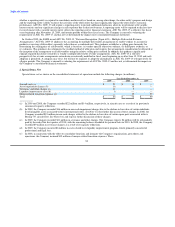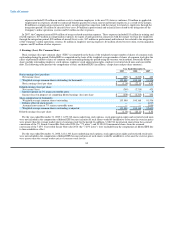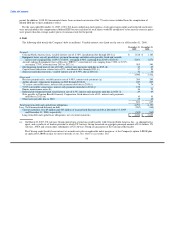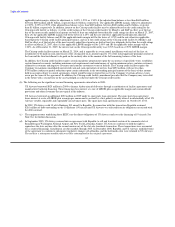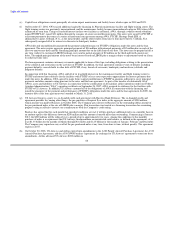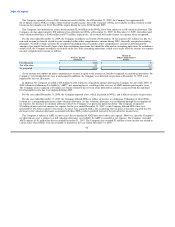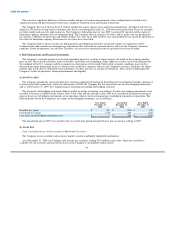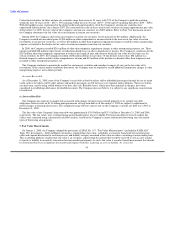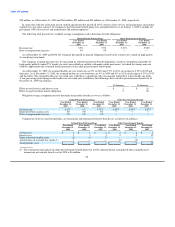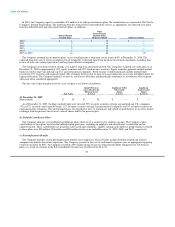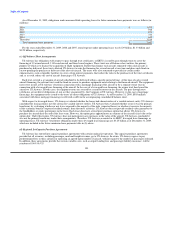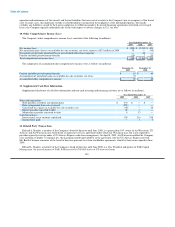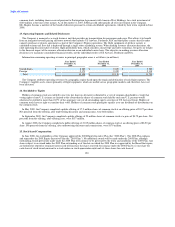US Airways 2009 Annual Report Download - page 96
Download and view the complete annual report
Please find page 96 of the 2009 US Airways annual report below. You can navigate through the pages in the report by either clicking on the pages listed below, or by using the keyword search tool below to find specific information within the annual report.
Table of Contents
The reason for significant differences between taxable and pre-tax book income primarily relates to depreciation on fixed assets,
employee pension and postretirement benefit costs, employee-related accruals and leasing transactions.
The Company files tax returns in the U.S. federal jurisdiction, and in various states and foreign jurisdictions. All federal and state tax
filings for US Airways Group and its subsidiaries for fiscal years through December 31, 2008 have been timely filed. There are currently
no federal audits and one state audit in process. The Company's federal income tax year 2005 was closed by operation of the statute of
limitations expiring, and there were no extensions filed. The Company files tax returns in 44 states, and its major state tax jurisdictions
are Arizona, California, Pennsylvania and North Carolina. Tax years up to 2004 for these state tax jurisdictions are closed by operation of
the statute of limitations expiring. Extensions for two states have been filed.
The Company believes that its income tax filing positions and deductions related to tax periods subject to examination will be
sustained upon audit and does not anticipate any adjustments that will result in a material adverse effect on the Company's financial
condition, results of operations, or cash flow. Therefore, no reserves for uncertain income tax positions have been recorded.
6. Risk Management and Financial Instruments
The Company's economic prospects are heavily dependent upon two variables it cannot control: the health of the economy and the
price of fuel. Due to the discretionary nature of business and leisure travel spending, airline industry revenues are heavily influenced by
the condition of the U.S. economy and the economies in other regions of the world. Unfavorable economic conditions may result in
decreased passenger demand for air travel, which in turn could have a negative effect on the Company's revenues. Similarly, the airline
industry may not be able to sufficiently raise ticket prices to offset increases in aviation jet fuel prices. These factors could impact the
Company's results of operations, financial performance and liquidity.
(a) Fuel Price Risk
The Company periodically enters into derivative contracts comprised of heating oil-based derivative instruments to hedge a portion of
its projected jet fuel requirements. Since the third quarter of 2008, the Company has not entered into any new fuel hedging transactions
and, as of December 31, 2009, the Company had no remaining outstanding fuel hedging contracts.
The Company's fuel hedging instruments did not qualify for hedge accounting. Accordingly, the derivative hedging instruments were
recorded as an asset or liability on the balance sheet at fair value and any changes in fair value were recorded in the period of change as
gains or losses on fuel hedging instruments, net in operating expenses in the accompanying consolidated statements of operations. The
following table details the Company's loss (gain) on fuel hedging instruments, net (in millions):
Year Ended Year Ended Year Ended
December 31, December 31, December 31,
2009 2008 2007
Realized loss (gain) $ 382 $ (140) $ (58)
Unrealized loss (gain) (375) 496 (187)
Loss (gain) on fuel hedging instruments, net $ 7 $ 356 $ (245)
The unrealized gains in 2009 were related to the reversal of prior period unrealized losses due to contracts settling in 2009.
(b) Credit Risk
Cash, Cash Equivalents and Investments in Marketable Securities
The Company invests available cash in money market securities and highly liquid debt instruments.
As of December 31, 2009, the Company held auction rate securities totaling $347 million at par value, which are classified as
available-for-sale securities and noncurrent assets on the Company's consolidated balance sheets.
94


